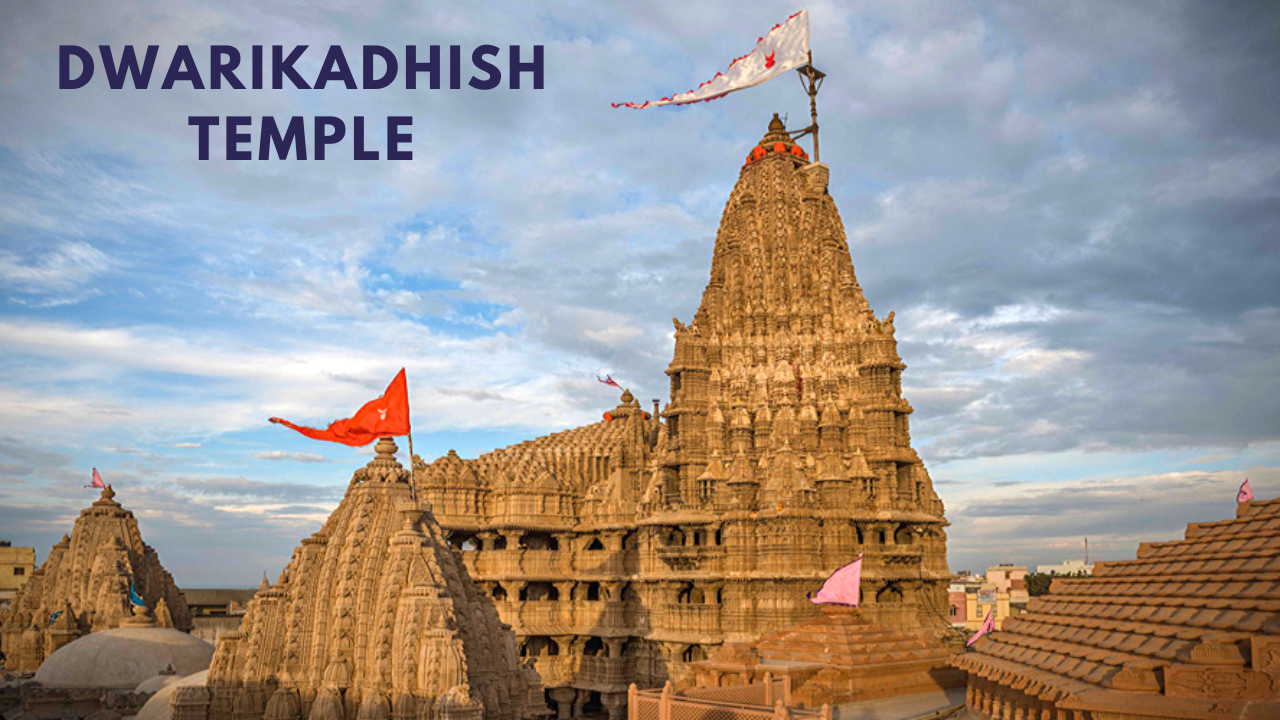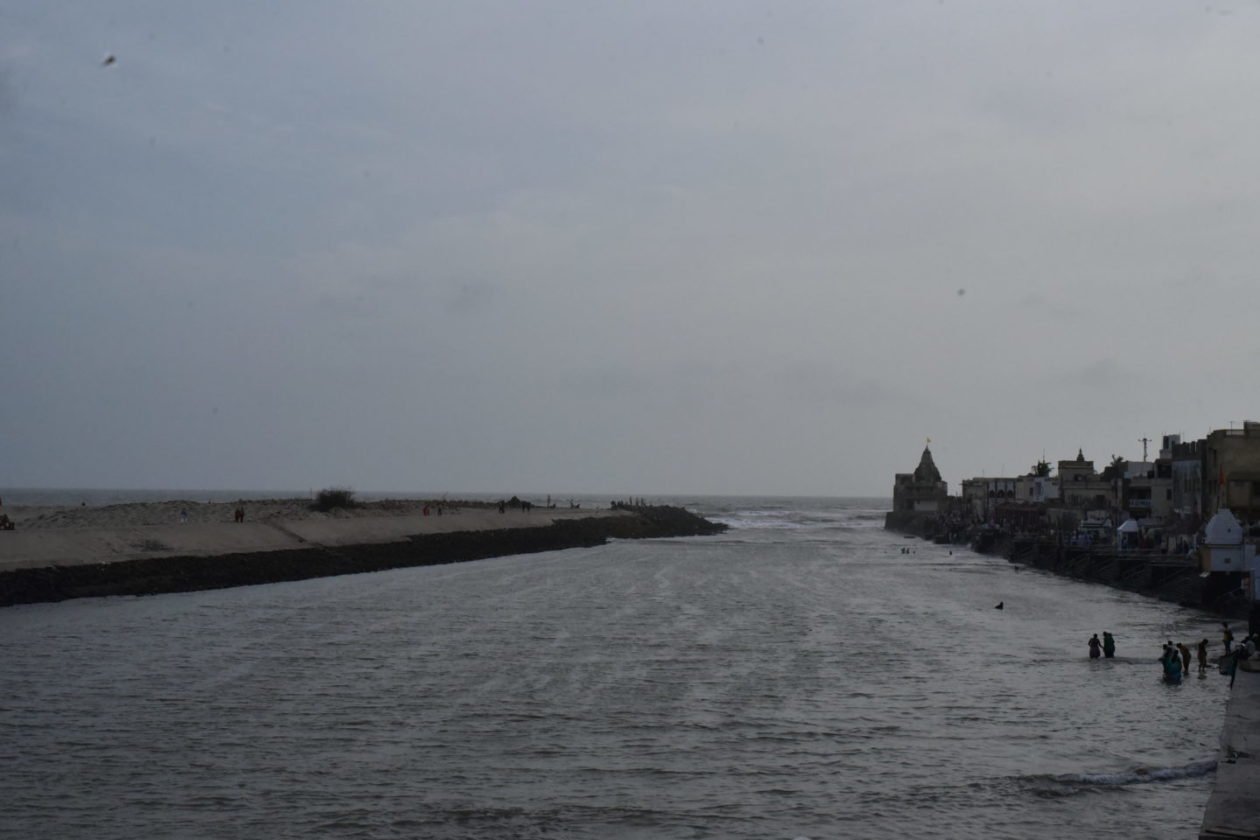An Insight Into Dwarkadhish Temple, Dwarka
Posted on June 14, 2020 by Ghoomophiro

This time we (Ghoomophirosisters) planned to pay a visit to one of the most popular temples in India, Dwarkadhish Temple. Irrespective of which road you decide to take when in Dwarka, you will land at Dwarkadhish temple standing elegantly on the western tip of incredible India exactly at the meeting point of River Gomti and Arabian sea. The sight of the temple becomes evident as soon as you enter Dwarka. Dwarkadhish is one of the loveliest temples that you will ever visit having a rare ancient structure that bears testimony to centuries. Right from the morning when the deity wakes till night when deity goes to sleep, there is plenty of activity going around in the premises giving you the celebration vibes and essence of Shringar Ras. Sri Dwarkadhish temple at some places is also popularly known as Jagat Mandir.
How to reach Dwarkadhish Temple
Depending upon the place where you want access to Dwarkadhish Temple, it is well connected to different parts of the world by road and rail. You can simply take a flight to Delhi from any part of India and from there you can take a train that drops you at Dwarka Railway station from where the temple is only at a distance of 1KM. We were already on our road trip from Rajkot to Dwarka.

Where to stay at Dwarka
There are plenty of hotels near the temple that offer good services at a decent price. You can opt to stay at one of the following hotels Hotel Roma Kristo, Hotel Guruprerna, Hotel City Palace, Hotel Devkinandan and Hotel Nilay that are at a distance of nearly one to two kilometers from the temple. We (Ghoomophirosisiters) stayed at VITS Devbhoomi.
Origin and history of Dwarkadhish Temple
As per the Pandas here the temple is claimed to be 5244 years old built by the great-grandson of Lord Krishna, Vajranabh. However, the present structure of the temple is basically an amalgamation of the parts spread widely and dates back to somewhere between 8th to 18th CE. The temple today stands at an elevation of around 80 meters or 250 feet having a 25 ft long flagstaff at the top. Dwarkadhish Temple is home to one of the 4 Shankaracharya Peethas, that is, Sharda Peetha.

Other Temples in the premises
There are a lot of other temples also with in the premises. These are Kusheshwar Mahadev, Navgrah Yantra, Aniruddha and Pradyumna Temple, Rishi Durvasa Temple, Amba Ji Temple, Devaki Temple, Radha Krishna Temple, Beni Madhav, Purushottam Rai & Balram Temples, and Pattarani Mahal. There are other small temples dedicated to Jambavati, Saraswati, Laxmi, Radhika, Satyabhama, Mahalaxmi Narayan, and Bal Gopal. Shakti temple or Chalati Mata temple situated on the 4th floor that is closed for the public.

Two gates of Dwarkadish Temple
Unlike other temples that usually have a single entrance, the Dwarkadhish temple has two entrances. The two entrances to the temple, north, and south are called Moksha Dwar and Swarg Dwar. There are 56 steps on Swarg Dwar side leading to temple from Gomti Ghats which according to the storytellers represent 56 Koti or 56 Crore Yadavas.
When to visit Dwarkadhish Temple
Throughout the year, you can visit the temple without having to worry much. However, what would be the best time to visit the place strictly depends on the purpose for which you want to visit the temple. If you are planning to set out on a holy pilgrimage to Dwarkadhish temple then winters are the ideal time. You can plan your visit anytime between the months of October to February as then the climate is also very cool and pleasant. In case you simply desire to pay a visit to the temple, then you can opt for other months as then the temple is supposed to be less crowded with the majority of visitors being locals leaving you ample time and space to explore the temple properly.
Best time to visit Dwarkadhish Temple
It is important to known the Dwarkadhish Temple Timings before heading out to pay a visit. The temple opens for the devotees at 6.30 AM with the awakening of the deity and remains open from 6:30 AM to 01:00 PM. It opens up again at 5:00 PM and finally, the doors are closed at 9.30 PM when deity goes off to sleep. You, therefore, ought to plan your visits in between these hours which is pretty much convenient. We (Ghoomophirosisiters) went to the temple in the early morning around 6.30 AM. Though each hour of the day has unique things to offer to you at the temple in the morning the rush of the devotees is comparatively less. This means that you get to explore the premises peacefully without having to rush. In the morning at 6.30 AM we attended the Mangla Arti and witnessed Mangla Darshan from 7.00 to 8.00 followed by one hour of Abhishek Pooja from 8.00 to 9.00 AM. From 9.00 to 9.30 we attended Shringar Darshan followed by 15 minutes of Snanbhog after which we explored the temple. Within the strict timing of the opening and shutting of temple doors, you at least need an hour to explore every nook and corner of the temple.
Dhwaja Arohan/ Flag Changing Ceremony
When at Dwarkadish temple, one thing that you will not miss in any case is the huge swaying flag right on top of Shikhara. Every time you look at the temple, you will amazingly find a different flag placed there. The reason behind this is that the flag is changed 5 times a day, three times in the morning and two times in the evening. There is a full-fledged ceremony followed each time the flag is changed. Following an elaborative puja, the family who sponsors the flag change also feed the Brahmins of Dwarka. The flag is brought to the temple on the head with pomp and show accompanied by dancing and singing and is offered to the deity. Thereafter, the Brahmin community goes up to change the flag. Once you have sponsored the flag you ought to wait for 2 years to do it once again. Except for black any color can be used to design the flag and is supposed to have an emblem of sun plus moon. There are dedicated tailors who are aware of all the rules and dimensions of stitching the flag.
Festivals celebrated at Dwarkadhish Temple
There are plenty of pious festivals that are celebrated with great zeal and energy at Dwarkadhish Temple. One of the most important festivals that are celebrated here is the birthday of Lord Krishna known as Janmashtami. Another festival celebrated here is Holi that comes in the month of March every year. Rukmini Vivah or in other words the wedding of Lord Krishna and Rukmini on Ekadashi of Chaitra month is another interesting festival celebrated on the premises. Basant Panchami, Akshay Tritiya, Deepawali, Ram Navami, Sharad Purnima, Dhanteras and New Year are some of the other events celebrated here.
Guggali Brahmins are responsible to perform all the rituals as well as ceremonies of Dwarkadhish Temple. The temple is visited by devotees throughout the day. There is no time in the temple when you feel that it is empty or overcrowded. One thing that we would like you to know is that you are not allowed to take photographs within the premises neither are any sort of electronic gadgets allowed inside the temple. Carry Tulsi and Marigold garlands to offer to the deity that you simply need to show to the deity and then you are supposed to get it back with you.





You wrote good blog and it is very useful and helpful
Thanks for sharing
https://tajwithguide.com/golden-triangle-tour.html